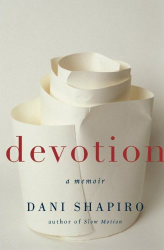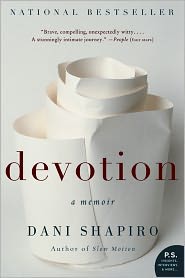I love books. I love reading. I love the power of words to transport us, change us, connect us.
One author I admire in every way — personally and professionally — is Dani Shapiro. This post from 2011 doesn’t talk about the details of her latest book Devotion, but I still want to repost it not only to encourage you to read the book for yourself but also because I think it’s intersting to think about how we interact with what we read. Dani has a new book coming out called Still Writing. There isn’t anyone to me who can capture the art of writing the way she can.
…………………………….
I’m not the kind of person who reads books twice. My husband wears down the fibers in the covers of some of his books, corners frayed by his hands as he holds and bends the written pages. Me? I barely have enough time to read a book once. My attention span is short, my free time small. With three children and a house to take care of there just doesn’t seem to be time to do everything I want.
This morning I awoke knowing what I wanted to do. I wanted to re-read sections of Dani Shapiro‘s second memoir, Devotion. About twenty pages into it I realized I was literally itching to do something: write in the book. I hadn’t allowed myself to do that the first time. Lately I had felt that my books (especially ones written by people I knew in person or on Twitter, even moreso if signed by the author) should remain pristine. I have eschewed e-readers in every form for this very reason… typing notes in margins is not as satisfying as using colored ink to have my interactive conversation with the author. Sometimes exclamation points or “YES!” will interrupt the creamy expanse of the margin, but more often than that my graduate school training has led me to issue challenges to the author. Questions that start with “But what about…” or the challenging, “Does not take into account…” are what you will find in my books. As I try to process what the author says I imagine I am conversing with them. And, in fact, I am; writers write to start a conversation with the reader. If all the reader does is absorb without processing I think the author might be disappointed.
As I started Dani’s book this morning I realized the pristine condition of my hardcover was getting in my way. I needed to interact with it to really get the full benefit of her words. It seems the right thing to do. Only pages in to this second time through, I was already finding questions I want to ask her. I was, after all, a different person by my second reading. I was coming to the book with more experiences, different concerns and thoughts than I previously had. I came to the book with many of the same questions Dani herself was seeking to answer when she started writing. I realized that in the same way she had made sense of what happened to her by writing, I needed to do that too. Writing in the margins was my microcosm of that experience; without “talking back” I had missed a lot of the beauty and significance of her words.
I already feel myself digesting her words in a different way. The same way I cannot experience major events in my life without writing I realized this morning I cannot make sense of words without reacting. As my memory has declined and my mental capacities have suffered over the past few years I can’t rely on them to retain the memories of the sentences and paragraphs that have spoken to me. I need to wrestle with them, tease them out, formulate responses.
My book will be riddled with ink by the time I am done. But I realized today that is precisely as it should be. I think Dani would like that. I think it means I’m learning.



 Link to Twitter
Link to Twitter